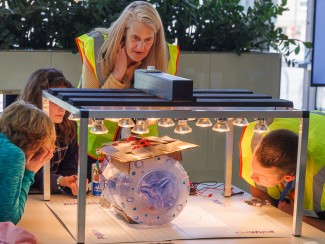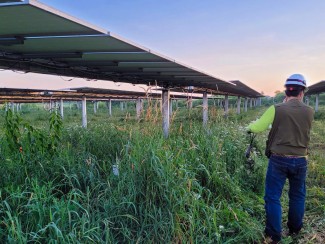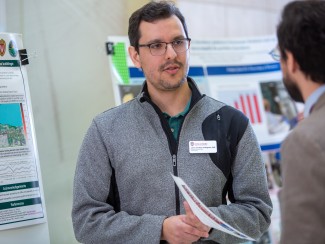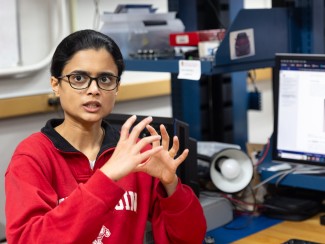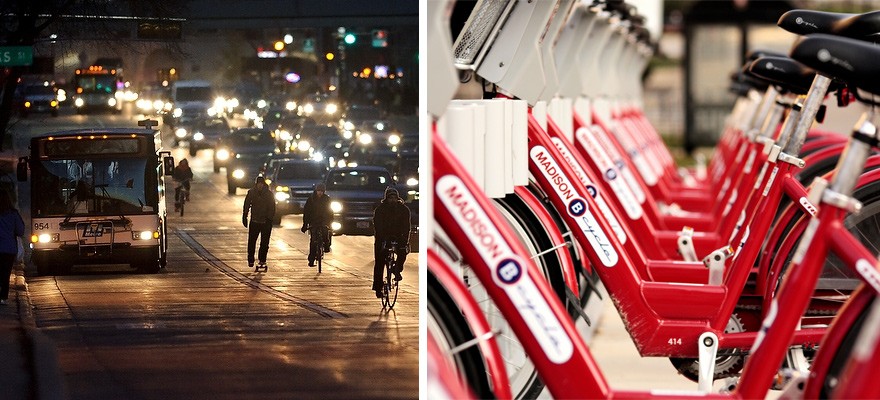
Like many local governments around the country, the City of Madison is trying to reduce its emissions of heat-trapping greenhouse gases (GHG) such as carbon dioxide. To achieve that goal, the city partnered with the University of Wisconsin–Madison in 2010 to produce its first-ever emissions inventory.
When it was time to update that inventory with 2014 data, the city turned to a team of UW–Madison graduate students from the Nelson Institute for Environmental Studies who, in the spring of 2015, were pursuing an Energy Analysis and Policy (EAP) certificate.
As part of the EAP certificate’s capstone project, Emily Howell, Alexandra Karambelas, Xiaomeng Jin, and Debaki Ale analyzed emission trends for specific energy sectors and proposed policy tools for reducing Madison’s carbon emissions.
“We identified transportation as a problem sector that accounts for 41% of GHG emissions,” Howell says. “This carbon footprint can be reduced by increasing the use of public transportation to commute to work. But to be successful, that strategy has to be tailored to Madison’s unique geography.”
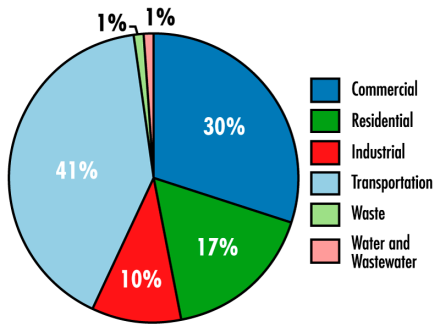
That unique geography is the isthmus, a narrow strip of land wedged between Lakes Mendota and Monona and the site of two of Madison’s largest employers, the state government and UW–Madison. Since only so many roads can fit on a narrow piece of land, traffic congestion during daily rush hours causes significant emission spikes.
To reduce those spikes, the students proposed transit-oriented city development: creating more living spaces around an isthmus-centered bus rapid transit (BRT) system.
By using dedicated lanes, off-board fare collection, few stops and frequent operations, BRT would be a much faster commuting system than Madison’s current bus service. Residential development around BRT would encourage a greater proportion of the population to use it.
“Dane County is predicted to experience 70% of Wisconsin’s population growth between now and 2050,” Howell says. “Therefore, transit-oriented development would go a long way toward the 80% reduction in GHG emissions, from the 2010 baseline, that the sustainability committee would like to achieve.”
As a second strategy, the students researched policies that other U.S. cities comparable to Madison are pursuing to boost their renewable energy portfolio. Key for this comparison is whether or not a city owns its electric utility. Since Madison does not, the students focused on a nearby city in the same situation: Minneapolis.
The group found that Minneapolis recently signed a first-of-its-kind renewable energy agreement with its privately owned electric utility. Increased communication between Madison’s sustainability committee and partners in Minneapolis may help make similar progress locally.
Also proposed was a benchmarking ordinance that would require all residential buildings to report their electricity and heating energy use. While nobody would be fined for consuming too much energy, research studies have demonstrated the effectiveness of this peer pressure system for reducing GHG emissions.
Going green is easier said than done, Howell says, but the number crunching helps prioritize efforts: while transit-oriented development is mostly Madison’s decision, other strategies strongly depend upon support from the state government, the privately owned electric utility, or both.
Some of the many lessons learned? “The utility world is a lot more complicated than I realized,” Howell says. “And city design is really important for developing realistic emission reduction strategies.”
See "UW-Madison Students Estimate Cost of Wisconsin's Clean Drinking Water" for coverage of another project conducted by UW–Madison students enrolled in the Energy Analysis and Policy (EAP) program.

